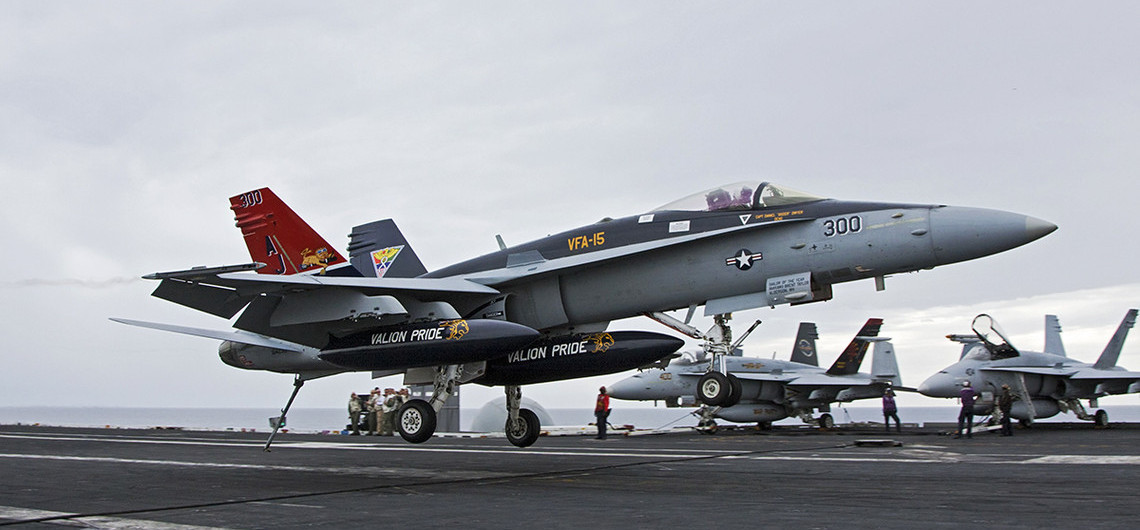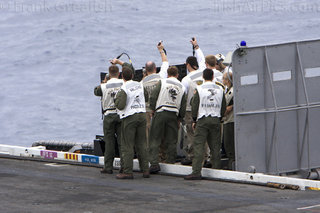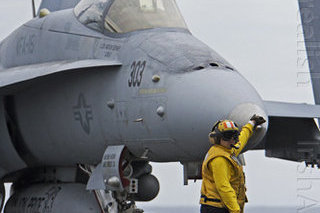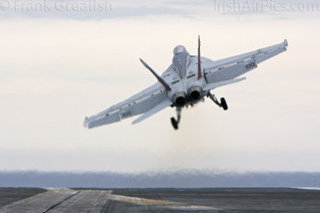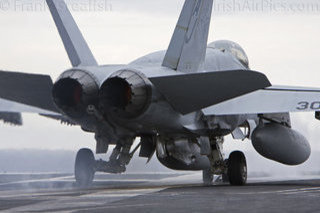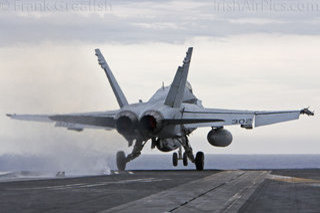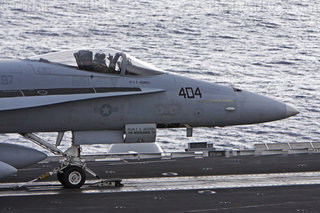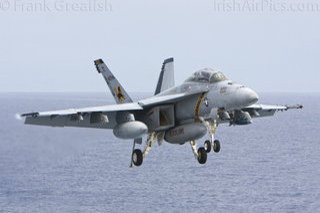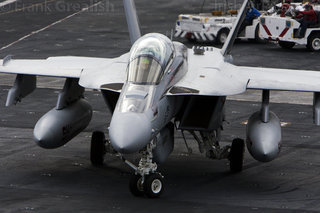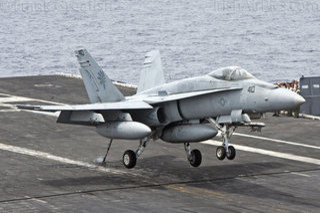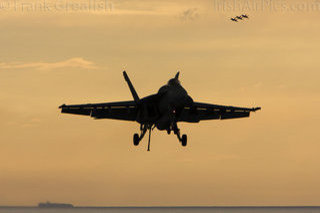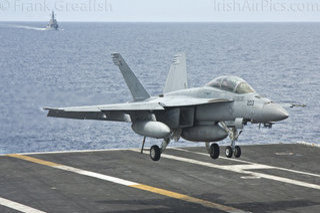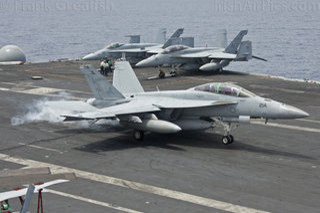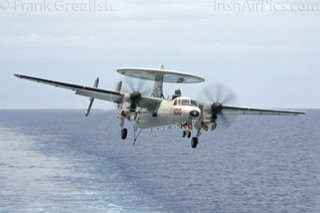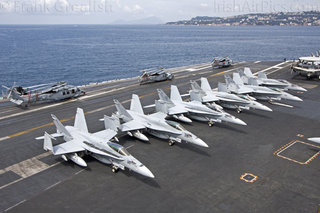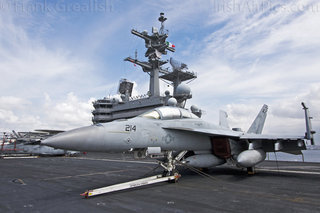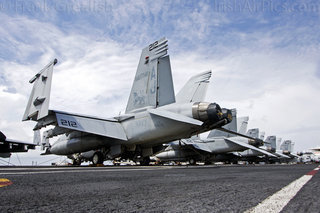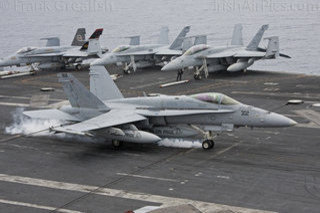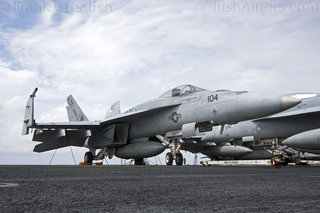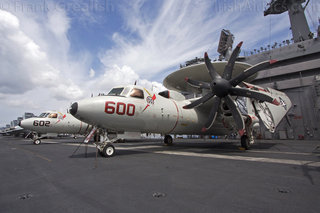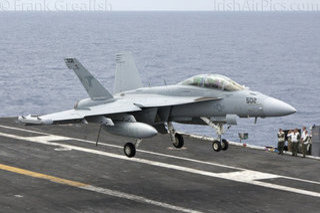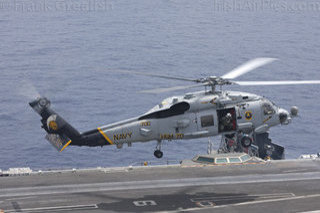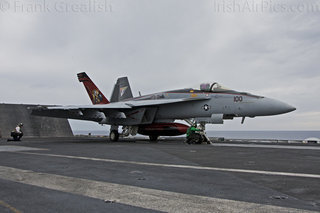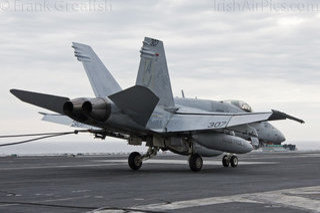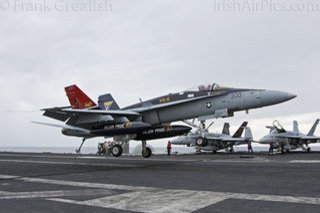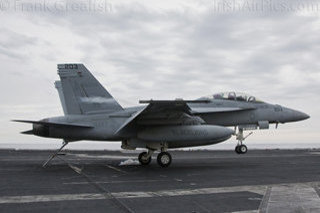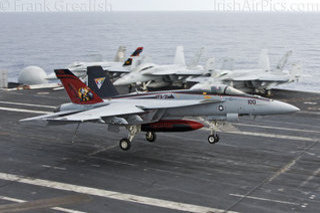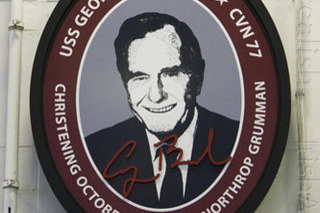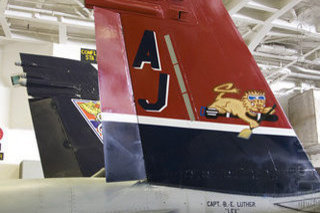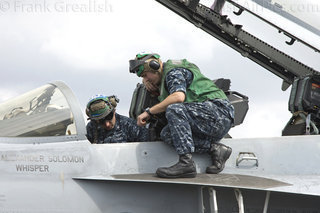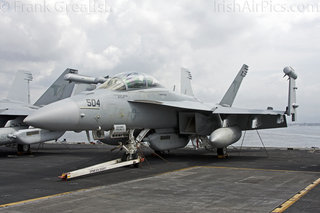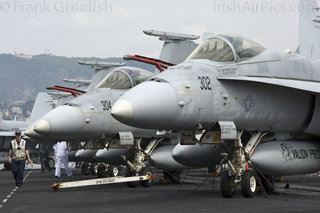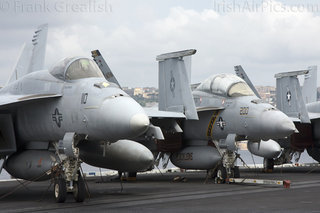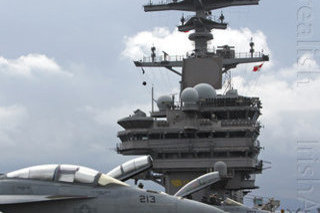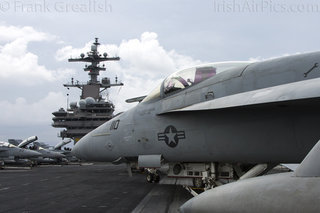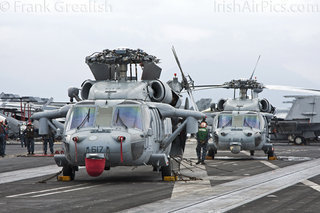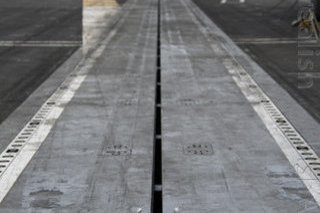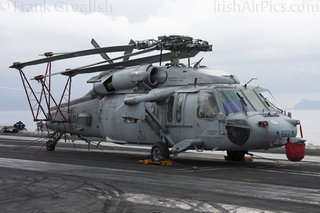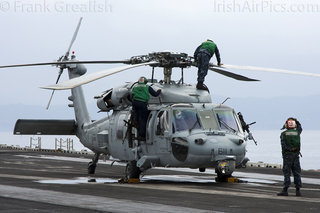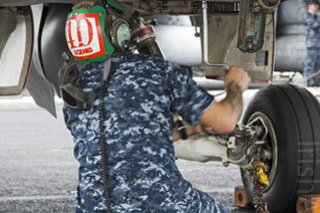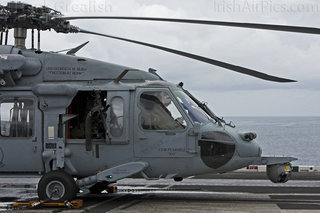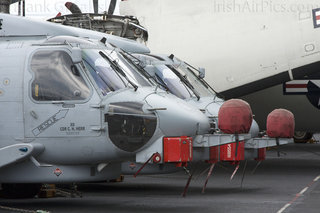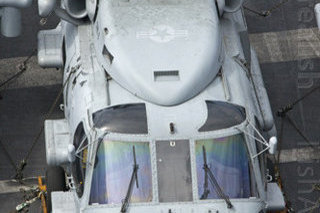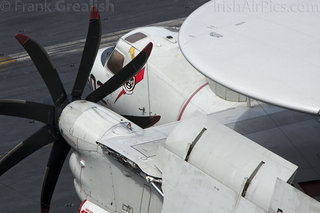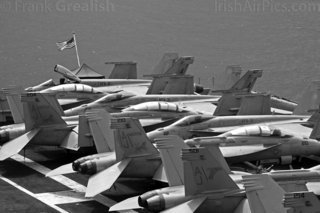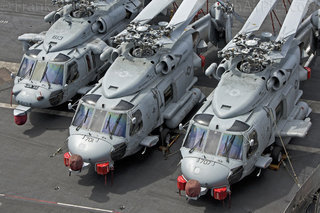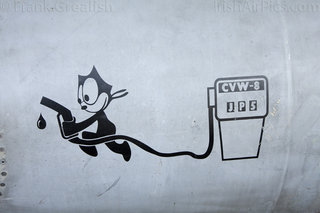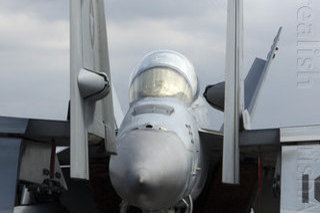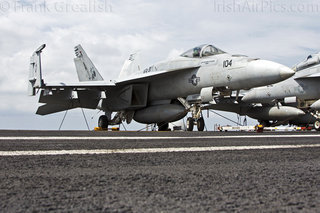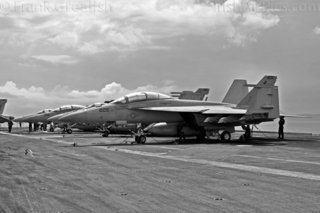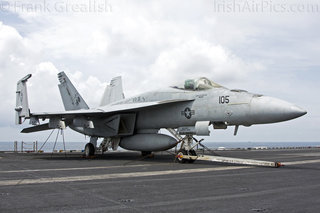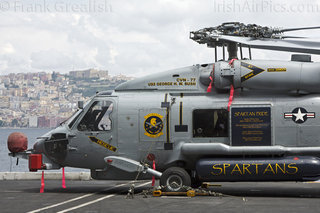CVN-77 USS George H.W. Bush
By Frank Grealish | June 2011 | At Sea, International Waters
The US Navy's newest aircraft carrier, the USS George H.W. Bush (CVN-77), is currently on its first overseas deployment and while it passed through the Mediterranean on its way to the 5th Fleet area of operations I got the opportunity to pay the ship a visit.
Assigned to the 5th Fleet, the Bush, its air wing, Carrier Air Wing Eight (CVW-8), and its associated battle group, Carrier Battle Group 2 (CSG-2), supports a variety of missions in an area of responsibility that includes the Red Sea, Persian Gulf, Arabian Sea, and the East African coast.
While the USS Bush has never been to Ireland, Irish readers may be familiar with CVW-8. CVW-8 was deployed aboard the USS John F. Kennedy (CV-67) when it paid a visit to Dun Laoghaire in the summer of 1996.
Aircraft from the carrier, including the famous F-14 Tomcat, did flypasts in various parts of the country including Wexford, Dublin and also at the Salthill Air Show.
Back to the present and the USS Bush, the Bush is the last of ten Nimitz class aircraft carriers to be commissioned by the US Navy but numerous changes have been made in the design that distinguish the Bush from other carriers in it's class.
Changes such as making the island smaller and moving if further aft than on other carriers give more space over to flight operations, the number of arrestor cables has been reduced from 4 to 3, jet blast deflectors have been re-designed while new jet fuel storage and refuelling systems have been installed to help make the refuelling process more efficient.
Carrier Air Wing Eight has eight squadrons on board with a combined total of over 2000 personnel and 70 plus aircraft. Four Strike Fighter squadrons operate "Legacy" Hornets (F/A-18A+, F/A-18C) and Super Hornets (F/A-18E & F), one Tactical Electronic Warfare squadron operates the EA-18G Growler, one Carrier Airborne Early Warning squadron flies E-2C Hawkeyes, while two helicopter units fly Sikorsky MH-60S/R Knighthawks.
Carrier Air Wing Eight also boasts a number of "firsts", Tactical Electronic Warfare squadron 141 (VAQ-141) Shadowhawks is making the first ever operational carrier deployment of the Boeing EA-18G Growler while Helicopter Maritime Strike Squadron 70 (HSM-70) Spartans is making the first operational deployment of the Sikorsky MH-60R "Romeo" by an east coast carrier unit.
Introducing the Romeo...
HSM-70 Spartans, one of CVW-8's two helicopter squadrons, has introduced a new helicopter type on the deployment, in the shape of the Sikorsky MH-60R Romeo. The MH-60R is designed to combine the features of the SH-60B and SH-60F into a multi-mission single helicopter platform.Operated by a crew of three, the MH-60R has a primary role of Anti Submarine Warfare (ASW) with secondary roles that include Search and Rescue (SAR), vertical replenishment (VERTREP), fire support, medical evacuation, and communications relay. All Helicopter Anti-Submarine (HS) and Helicopter Anti-Submarine Light (HSL) squadrons that receive the MH-60R will be re-designated Helicopter Maritime Strike (HSM) squadrons.
...Followed by the Growler
The EA-18G Growler operated by VAQ-141 is an electronic attack derivative of the F/A-18F Super Hornet and replaces the EA-6B Prowler on board the carrier. The Growler has more than 90% commonality with a standard Super Hornet, both aircraft have similar flight and performance characteristics, this similarity allowing the Growler to fly with the strike package and perform escort jamming in addition to the more traditional standoff jamming role.The Growler and Super Hornet share an airframe, the Raytheon AN/APG-79 AESA radar and weapon systems such as the AN/AYK-22 Stores Management System. Most of the Growlers electronic attack equipment is mounted in the space that used to house the internal 20 mm cannon while AN/ALQ-218 wideband receivers pods replace the missile launch rails on the wingtips.
Nine weapons stations remain free to provide for additional weapons or jamming pods. The Growler can be fitted with up to five ALQ-99 high and low-band tactical jamming pods and can also carry AIM-120 AMRAAM or AGM-88 HARM missiles.
The ALQ-218 wingtip pods combined with the ALQ-99 pods form a full spectrum electronic warfare suite that is able to provide detection and jamming against all known surface-to-air threats.
CDR Karl J. Pugh, the former CO of VAQ-141, said that "even though the EA-6B had four aircrew in the cockpit where the EA-18G has just the two, the massive leap in technology makes the changeover very smooth. You are going from a 1960s platform to a 1990s platform. The amount of data that is received into the cockpit is overwhelming. When it comes to electronic warfare, in general it's all about information and how you absorb and understand it in context and then react to it.
We have young guys and we have olds guys in the squadron, who each bring their own way of integrating to the platform. The young guys are native to digital. They see the aircraft and the mission from a different vantage point. The combination in the cockpit of experience plus youth allow us to use the technology to its full advantage."
Hornets Galore
The strike aircraft on the USS Bush, as mentioned earlier, all consist of different versions of the same aircraft family, the Boeing F/A-18 Hornet / Super Hornet. The consolidation of aircraft types to a common airframe creates efficiencies in terms of maintenance, logistics, and launching multiple aircraft.Strike Fighter Squadron 31 (VFA-31) Tomcatters fly the F/A-18E while Strike Fighter Squadron 213 (VFA-213) Black Lions fly the F/A-18F. Both units are former Tomcat units and in 2006 when the Tomcat was withdrawn from service, aircrews were wearing patches declaring "Tomcat by choice, Hornet by mandate". 5 years on those sentiments have been long forgotten and aircrews have firmly embraced the capabilities of the Super Hornet over the Tomcat.
In addition to the strike role the Super Hornets also re-introduce the buddy refuelling role to the carrier, filling the gap left when the Navy retired the KA-6D Intruder and S-3 Viking.
VFA-213 was the first Super Hornet squadron in the Navy to fly AESA-equipped aircraft and it also the only squadron on board the Bush that is trained to conduct the Forward Air Control (Airborne) mission.
A big thank you goes to...
I would like to thank Captain Jeffrey A. Davis, Commanding Officer, Carrier Air Wing 8 and Captain Brian "Lex" Luther, Commanding Officer of the USS Bush for having me on board the ship and giving us an insight into operations on the US Navy's newest carrier.
Thanks also go to Commander Monica Rousselow of 6th Fleet Public Affairs; Lieutenant Commander Linda Sweeney, Ensign Matthew Stroup, and the rest of the USS Bush PAO Team.
Last but not least a big thank you must go to Lieutenant Ken Radford, our ever patient and helpful escort.

